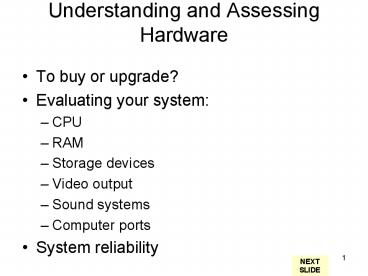Understanding and Assessing Hardware - PowerPoint PPT Presentation
1 / 25
Title:
Understanding and Assessing Hardware
Description:
CD/DVD. Flash memory. Nonvolatile storage. NEXT. SLIDE. 9 ... Replace CD ROM with CD-R/RW or DVD-R/RW. Flash card reader. Flash memory drive. Hard drive ... – PowerPoint PPT presentation
Number of Views:126
Avg rating:3.0/5.0
Title: Understanding and Assessing Hardware
1
Understanding and Assessing Hardware
- To buy or upgrade?
- Evaluating your system
- CPU
- RAM
- Storage devices
- Video output
- Sound systems
- Computer ports
- System reliability
NEXT SLIDE
2
To Buy or To Upgrade?
- Things to consider
- Moores Law
- Cost of upgrading vs. buying
- Time installing software and files
- Needs and wants
NEXT SLIDE
3
Assessing Your Hardware Evaluating Your System
- Assess the computers subsystems
- The subsystems include
- CPU
- RAM
- Virtual memory
- Storage devices
- Video
- Audio
- Ports
NEXT SLIDE
4
Evaluating the CPU
- How does the CPU work?
- Control unit
- Arithmetic logic unit (ALU)
- Machine cycle
- Fetch
- Decode
- Execute
- Store
- Speed
- Mhz
- Ghz
NEXT SLIDE
5
Upgrading the CPU
- Expensive
- Easy to install
- Motherboard compatibility
NEXT SLIDE
6
Evaluating RAM
- Random access memory (RAM)
- Temporary storage (memory)
- Volatile
- Memory modules
- SIMM
- DIMM
- RIMM
- Types of RAM
- SRAM
- DRAM
- SDRAM
NEXT SLIDE
7
Adding RAM
- Increase system performance
- Things to consider
- Type of RAM module
- Amount of RAM
- Maximum limit
- Number of slots
- Operating system
- Applications running at the same time
NEXT SLIDE
8
Evaluating Storage
- Types of storage devices
- Hard drive
- Floppy drive
- Zip disk drive
- CD/DVD
- Flash memory
- Nonvolatile storage
NEXT SLIDE
9
Storing Data
- Magnetic media
- Metal platters
- Hard disks
- Plastic film
- Floppy disks
- Zip disks
- Tracks
- Sectors
- File Allocation Table
Track
Sector
NEXT SLIDE
10
Storing Data
- Optical media
- CD ROM
- CD-R
- CD-RW
- DVD ROM
- DVD-R
- DVD-RW
- Laser
- Pit
- Land
NEXT SLIDE
11
The Hard Disk Drive
- Storage capacity up to 400 GB (or ?)
- Access time is measured in milliseconds
- Data transfer rate is measured in megabits or
megabytes per second - Spindle speed is measured in revolutions per
minute (rpm)
Read/write head
Platters
Access arms
NEXT SLIDE
12
Portable Storage
- Gives us the ability to move data from one
computer to another - Types of portable storage devices
- Floppy disk
- Capacity 1.44 MB
- Zip disk
- Capacity 100 MB to 750 MB
- CD-R, CD-RW, DVD-R, DVD-RW
- (CD 650 MB, DVD 17GB)
- Flash drive
- Capacity 32 MB to X GB
NEXT SLIDE
13
Upgrading Storage
- Hard drive options
- Replace current drive with a larger capacity
drive - Install an additional hard drive
- Other options
- Zip drive
- Replace CD ROM with CD-R/RW or DVD-R/RW
- Flash card reader
- Flash memory drive
Flash card reader
CD/DVD
Hard drive
Floppy/Zip drive
NEXT SLIDE
14
Evaluating Video
- Two components
- Video card (adapter)
- Monitor
NEXT SLIDE
15
Video Cards
- Process binary data into images
- Contain memory known as video RAM (VRAM)
- Control the number of colors a monitor can
display (bit depth) - Standard VGA
- 4 bits
- 16 colors
- True color (SVGA)
- 24 bits
- 16 million colors
NEXT SLIDE
16
Monitors
- Things to consider
- Types
- CRT or LCD
- Size
- 15, 17, 19, or 21 inch
- Resolution
- Increasing resolution allows more to be displayed
- Dot pitch
- .31mm or less
- Refresh rate
- 75 Hz or higher
NEXT SLIDE
17
Evaluating Audio
- Speakers
- Amplified
- Not amplified
- Sub-woofer
- Sound card
- Process digital data into sounds
- 3D sound cards
- Surround sound
- Dolby Digital 5.1
NEXT SLIDE
18
Evaluating Ports
- Ports are used to connect peripheral devices to
the computer - Things to consider
- Devices you want to use
- Ports needed for the devices
NEXT SLIDE
19
Types of Ports
- Serial
- Parallel
- Universal serial bus
- FireWire
- Ethernet
- IrDA
- Bluetooth
Transfers data one bit at a time 56Kbps
Transfers eight bits of data simultaneously
12Mbps
Transfer speed up to 480Mbps Hot swapping
Transfer rate of 100 Mbps connects computers to
networks
Transfer rate of 4 Mbps Uses infrared light waves
Transfer rate of 1 Mbps radio waves send data
over short distances
Transfer rate of 400 Mbps Digital cameras
NEXT SLIDE
20
Adding Ports
- Expansion cards
- New port standards
- Expansion hubs
- Enables several devices to be connected to a port
NEXT SLIDE
21
Evaluating System Reliability
- Performance
- Slow
- Freezes
- Crashes
- Upkeep and maintenance
- System tools
- Control panel
- Update software and hardware drivers
- The last resort
NEXT SLIDE
22
Upkeep and Maintenance
- System tools
- Disk defragmenter
- Disk cleanup
- Unnecessary files
- Control panel
- Add/remove programs
- Display
- System
- Device manager
NEXT SLIDE
23
Update Software and Hardware Drivers
- Software
- Automatic updates
- Patches
- Hardware
- Download updated drivers
NEXT SLIDE
24
The Last Resort
- If problems persist
- Reinstall the operating system
- Upgrade the operating system to the latest version
NEXT SLIDE
25
The Final Decision
- How closely does your system come to meeting your
needs? - How much would it cost to upgrade your system?
- How much would it cost to purchase a new system?
NEXT SLIDE
26
(No Transcript)































